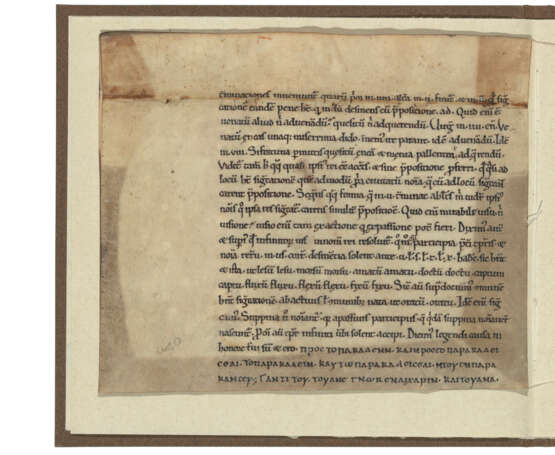ID 869433
Lot 37 | Priscian (fl. 6th century)
Estimate value
£ 2 000 – 3 000
Two fragments from Institutiones Grammaticae in Latin and transliterated Greek, manuscript on vellum [England, first(?) quarter 12th century].
Early fragments from the great grammatical textbook of the Middle Ages.
The upper part of two leaves, c. 135 × 165mm and c. 120 × 165mm, blind ruled, preserving up to 20 lines per page written in a very fine English bookhand, the transliterated Greek mostly in majuscules (but ‘p’ and ‘y’ have descenders), the text comprising two non-consecutive parts of Book 8 (‘[preponere]tur omnibus […] tutus habere sena[tum]’ and ‘[preposi]tione nos in do utimur […] KAITOYANA| (for καὶ τοῦ ἀνα[γνωσθήσεσθαι])’), with a few lines of 12th- or 13th-century marginalia (recovered from use as a flyleaves in a tanned leather binding, with consequent stains, folds, etc., but with wide upper and outer margins and fully legible).
Provenance:
Colker MS 307; acquired in 1983 from Maggs.
Priscian’s most famous work, the Institutiones Grammaticae, surviving today in some 1000 copies, is a systematic exposition of Latin grammar based on the works of Herodian and Apollonius: it had a profound influence on the teaching of Latin and indeed of grammar in the West. But it was also important because in order to illustrate grammatical points, it also quotes - in addition to the great Latin authors of Classical Antiquity - the work of authors who would otherwise have been lost, including Ennius, Pacuvius, Accius, Lucilius, Cato and Varro. The Institutiones are divided into eighteen books, of which the first sixteen deal with sounds, word-formation and inflexions; the final two with syntax. The present fragments preserve part of Book 8, the first of three books concerning verbs.
Margaret Gibson, ‘Priscian Institutiones Grammaticae: a handlist of manuscripts’, Scriptorium 27 (1972), pp. 105–24 lists 527 medieval manuscripts, the majority of which are 12th-century or older.
| Place of origin: | United Kingdom |
|---|---|
| Auction house category: | Medieval & renaissance manuscripts |
| Place of origin: | United Kingdom |
|---|---|
| Auction house category: | Medieval & renaissance manuscripts |
| Address of auction |
CHRISTIE'S 8 King Street, St. James's SW1Y 6QT London United Kingdom | |
|---|---|---|
| Preview |
| |
| Phone | +44 (0)20 7839 9060 | |
| Buyer Premium | see on Website | |
| Conditions of purchase | Conditions of purchase |





